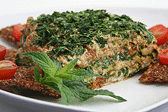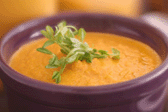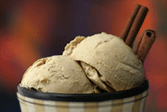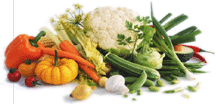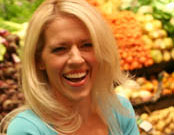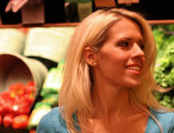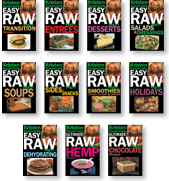Frequently Asked Questions
How can I make myself more alkaline and less acidic?
Acid-alkaline balance is important. Processed food, cooked food diets, pollution, and stress leave most people's blood pH very acidic, which prevents optimal cellular activity and immune system functions, and leaches alkaline minerals from the body (such as dissolving away calcium from your bones). Meat, dairy, processed sugar, starches and most grains, and most nuts and seeds are acid-forming. Fortunately, fruits and vegetables are alkalizing, so eating more of these and fewer of the acidifying foods creates an optimal blood pH level.
Where do I get my vitamin B12?
Because plants don't produce vitamin B12, the uninformed commonly suggest meat as a source of the vitamin. However, B12 is actually not a chemical compound, it's a microbe — a bacteria that thrives in soil, not in digestive tracts. Animal flesh is therefore not an original source of the vitamin. B12 is co-incidentally found in beef, for instance, because cattle ingest the microbe when they graze in fields or eat unwashed feed. Pre-industrial humans received more than adequate amounts of B12 in small amounts of soil consumed on unwashed vegetables. Today, our vegetables are usually washed before we eat them (and severely nutrient-depleted if you're not buying organic) meaning vegans need to make sure that they are absorbing adequate amounts of B12.
But the key word is "absorbing." According to Marieb's Human Anatomy and Physiology, vitamin B12 can be destroyed by highly alkaline and highly acid conditions. This means that the B12 in meat would be easily destroyed by the high levels of hydrochloric acid produced by our stomachs during the digestion of meat. This may explain why meat-eaters are statistically just as likely to have a B12 deficiency as vegans, even though their diet contains more of the vitamin. Also, for meat-eaters, as a result of modern factory farming techniques, there are antibiotics contained in meat that are lethal to the vitamin B12 microbe. Dr. Gabriel Cousens argues that vitamin B12 deficiency is typically caused by lack of absorption in the intestinal tract rather than a lack of this vitamin in the diet. So, improve your digestion and improve your assimilation of vitamin B12.
Alternatively, you may choose to supplement your B12. An excellent source is through Red Star Nutritional Yeast.
When your digestive system is in top shape from eating a Raw diet, then this ceases to become an issue for most people. We naturally produce some of our own B12, from microbes living in the tissues around the base of the tongue and the nasopharyngeal passages, as well as the colon.
In my opinion, I wouldn't worry about supplementing with B12 unless you're told you have a deficiency. This is easily determined with a simple blood test. Have your doctor run one the next time you get your blood work done, which is probably annually (and fun, as you watch your cholesterol drop fast once you start going Raw/vegan). I'll bet you find you're not deficient. I personally do not supplement B12 but my levels are always adequate.
What is detoxification?
After a period of time, the body builds up toxins and natural waste products from chemicals, pollution and indulging in foods that are harder for the body to handle. A process of cleansing the internal system, or "detoxifying," helps rid the body of harmful chemicals that may be contributing to fatigue, illness, pain, and poor digestion. When you remove toxin-laden foods from your diet, the body's resources are freed up to remove toxins that have been building up in the body, often for many years. During detoxification, the body eliminates these built-up toxins the same way it always does, through your eliminative organs: the skin, bowel, urinary tract, etc. Shifting to a vegan and/or Raw diet therefore is often initially accompanied by cold or allergy-like symptoms, particularly the production of phlegm. This is temporary and also can be quite a satisfying experience once you realize that the mucus your body is expelling is literally garbage that you've been carrying around in your tissue for a long time. And once it's out, it's out, leaving your detoxified body in a much healthier, cleaner, efficient state.
Fasting, in its various forms (no food, water-only, fruit-juice-only, green-juice-only, etc.) often produces the most dramatic detoxification effects, as the body is finally able to cleanse its digestive tract from years of toxin and mucous build-up. The effects range from bad breath, to a pasty, white coating of the tongue, to scary-looking things in your bowel movement. Nasty, to be sure, but that's precisely why we want to get this gunk out of our systems. When the detox symptoms disappear, it means the body is clean.
What is chlorophyll?
Chlorophyll is the green pigment molecule in plants and is responsible for absorbing the sun's energy for photosynthesis. The chlorophyll molecule in plants is chemically similar to hemoglobin in human blood. The only difference in the two molecules is that the central atom in chlorophyll is magnesium, whereas in humans it is iron. As a food supplement, chlorophyll can detoxify and purify the blood and liver, help build red blood cells and aid in tissue repair.
What is wheatgrass?
Wheatgrass is a type of grass that can be juiced and drunk straight (intense) or added to juice and smoothies. Wheatgrass that is certified organic produces very high concentrations of chlorophyll, enzymes and vitamins. Wheatgrass is a plant that has the nutrient profile similar to that of other leafy green vegetables and contains vitamins A, B complex, C and E, trace elements calcium, iron, magnesium and potassium, enzymes and amino acids. As an antioxidant, organic wheat grass can boost the immune system and scavenge free radicals. Organic wheatgrass has been shown to be a powerful body detoxifier. Its high chlorophyll content cleanses the liver, tissues and cells and purifies the blood. Organic wheatgrass also contains folic acid, iron, and vitamin B-12, which are required for proper red blood cell production.
What are sea vegetables and where can I get them?
Sea veggies can contribute a lot to a Raw/living foods diet: minerals, enzymes, vitamins, protein, healing fiber, and marine phyto-chemicals. Sea vegetables contain significant amounts of vitamins, especially the B vitamins. A serving of Dulse (about 7g, 1/3 cup) provides about 10% RDA Vit B-2 (Riboflavin) and about 42% RDA Vit B-6. Laver is rich in these B-vitamins and also contains 7% to 10% RDA Vitamin A. Alaria offers even more Vit A, up to 20% RDA, along with the B vitamins. You can find sea veggies at health food stores and on the Internet (see Seaveg.com).
Is hemp a healthy source of protein?
Emphatically, yes! Think seeds and oils, not Grateful Dead concerts. Hemp is commonly referred to as a "superfood" because of its amazing nutritional value. Hemp's amino acid profile dominates with its 8 essential amino acids (10 if you're elderly or a baby), making it a vegetarian source of "complete" protein. Hemp also comes naturally equipped with the World Health Organization's recommended ideal ratio of omega-6 to omega-3 fatty acids. Hemp is also gaining popularity because it offers an easy to digest source of protein (unlike soy, which is difficult for some people to digest), as well as other important nutrients such as fiber, vitamins, and minerals like magnesium, iron, and phosphorus. Last but definitely not least, hemp is an important industrial crop that is great for the earth. According to Keith Watson, a hemp crop specialist with Manitoba Agriculture, “Hemp is a sturdy crop that grows tall and fast, which means it outcompetes weeds.” Hemp is automatically organic because no pesticides or herbicides are needed to produce massive yields. This makes it one of the lowest cost, highest value crops on the planet.
The crazy legal scoop on hemp: In the US, hemp products can be purchased in healthfood stores and online. But hemp presently costs much more than it should, due to rather absurd laws that make it illegal to grow hemp in the US, but legal to import it, meaning all hemp products sold in the US are necessarily imported. Aside from hemp's amazing food uses, its fiber is comparable to cotton, but stronger and much longer-lasting. (Cotton is also one of the most pesticide-laden crops on the planet, whereas hemp uses none and lasts for years and years.) George Washington grew hemp on his plantation. Columbus' ships had sails made of hemp fabric. The Connestoga wagons that tamed the frontier were covered with hemp canvas. But in 1970, growing hemp was outlawed in the US due to... get this... the shape of its leaf! Hemp has no narcotic properties, but it is in the same family as marijuana, with a similar-looking leaf. In the early days of the War on Drugs, federal regulators felt that legal hemp crops would make it difficult to enforce bans on growing marijuana due to possible confusion between the plants. Other countries followed suit with similar bans. After gauging the significant economic impact of several decades of this very flawed policy, in the 1990's, most Western countries reversed these laws. The US is the laggard, which is why we must import hemp today (mostly from Canada), to the detriment of American farmers and consumers' pocketbooks. Recently, consumers have become more aware of hemp's advantages, driving growing demand for hemp-based foods and textile products. As this demand has increased, so have import volumes. Then add the fact that hemp is a great source of biofuel, bio-degradable plastics, and chemicals currently made from foreign oil. Several agriculture-intensive US states have challenged the federal restrictions and it is probably just a matter of time before hemp farming is legalized in the US.
Can you eat too many greens?
Balance is the key to everything. It's important to rotate the foods you eat, including greens. One way to do this easily is by eating seasonally with your produce. Another way, for greens especially, is to vary each week with the greens you eat. You'll find that chomping and chomping on endless amounts of greens will result in massiter fatigue (that is, a tired jaw muscle). It turns out that this is one of the body's satiety cues, meaning you'll naturally be inclined to stop eating, which is a useful strategy if you're trying to lose weight. If you're not trying to lose weight, then you can consume far more greens by blending them into a smoothie, but the high fiber content may eventually make you feel bloated. The best option for many people is to juice a lot of their greens, which removes the fiber (plant pulp), allowing you to consume literally as many greens as you'd like.
(A word about balance... some things are harmful even in small amounts. Dr. Caldwell Esselstyn of the Cleveland Clinic is one of the world's leading authorities on reversing heart disease through diet. He urges that, when it comes to cholesterol, "moderation kills." When asked about the effects of an occasional steak or slice of pizza, Dr. Esselstyn says, "We now know that a single fatty meal compromises coronary flow. This is true even in young people. You can see it with a scan five minutes later.")
Can I drink alcohol on a Raw diet?
Yes, wine is considered a Raw food. Be sure to look for organic wine that is low in sulfites or without added sulfites. This is sometimes a point of confusion because sulfites occur naturally even in 100% organically produced wine. According to Professor Roger Boulton, Ph.D., of UC Davis' Department of Viticulture and Enology, even if no sulfur dioxide is added to wine, fermenting yeasts will produce SO2 from the naturally occurring inorganic sulfates in all grape juices. Thus, says Boulton, it is impossible for any wine to be completely free of sulfur dioxide.
Once you go Raw, expect to feel the effects of alcohol more quickly and strongly, as your body will have become very efficient at absorption. Until you discover your new, lower tolerance for alcohol, be very careful when you drink, especially if you'll be driving.
Will there be variety with a Raw food diet?
Having variety in your diet is important so that you don’t get bored. That’s why they say, “variety is the spice of life.” (It's also why I developed nearly 300 easy recipes for my Raw foods recipe ebooks.) Getting variety with a Raw plant-based diet can be as easy as using different produce seasonally, weekly, and even daily. I find that most people crave variety (especially in the beginning stages of going Raw) because they’re used to variety in their previous diets and because they’re minds need it in order to stay motivated.
This big need for variety tends to actually decrease over time. So, while you think you want variety now, I'll bet that after being Raw for a short period of time, you'll be totally content with eating minimal variety. That might not help you in this moment right now though. Raw food has many different dishes available to give you variety from lasagna to veggie burgers to granola to nut milk to burritos and more. Here is a real simple trick that you can simply apply to having varied salads. Make salads with minimal ingredients so they're easy to change. For example, on one day your salad might be romaine lettuce, red bell peppers, cucumber, raisins, dressing, and alfalfa sprouts. Then the next day, it might be romaine or spinach, tomatoes, carrots, dried cranberries, and pea sprouts. The take-away here is that if you keep the salads somewhat simple, you can easily get variety since you can have different fruits and veggies each day.
How do I get my chocolate fix?
Easy. Eat raw chocolate, or better known in the Raw Food world as “Cacao Beans and Nibs.” Some say, and I agree, that “raw chocolate is the new red wine.” And why shouldn’t it be? Studies show raw chocolate as being the number one source of magnesium, as well as the number one source of antioxidants of any whole food. And, it contains phenylethylamine (PEA) — this is what our brains secrete when we fall in love. Need I say more?
You can eat the Cacao Beans or Nibs straight up or you can grind them into a powder and mix with dried fruit, agave nectar or raw almond butter (divine!). You can purchase raw chocolate powder and cacao nibs here. There is so much you can do with raw chocolate, which is why I teach an entire class dedicated to raw chocolate called Raw Chocoholics Anonymous.
How can I get off my addiction to caffeine?
Start drinking more green juices, including wheat grass, which will help alkalize your blood and reduce cravings for coffee and caffeine. To help avoid withdrawl problems, consider migrating off gradually with half decaf, working your way to 100% decaf or hot tea. Remember, part of the addiction can be the experience (going to a cafe or wrapping your hands around a big, warm mug), so look for ways to replicate the experience without the caffeine.
What if I miss the aroma of cooked food?
Consider this: Have you ever noticed that no cooked food smells good once it's cold? Imagine cold pizza or Chinese take-out. At best, it smells like nothing; at worst, it smells like garbage. Our bodies, digestive systems, and metabolisms evolved for millions of years without any cooking at all. If you have to heat something up to make it appetizing, doesn't that strike you that maybe something isn't quite right?
Cooked food smells good, to be sure. But have you ever thought about what exactly that smell is? It's not just air; it's air and moisture carrying millions of molecules away from the food — literally, organic compounds that used to be in the food are dispersing into the atmosphere every time you smell food. Unfortunately, these compounds are precisely the same nutrients that make Raw food so healthy. If you can smell the food cooking, you are directly experiencing the food losing its nutritional value.
It's very simple: When you cook living food, you kill it. That's not just a metaphor, fresh Raw plants literally are alive. They still have living, metabolic, and enzymatic processes going on inside their cells. When you think about it this way, the idea of enjoying their dying aroma almost seems perverse, like enjoying watching the soul leave a body because it looks beautiful. Wouldn't you rather preserve that living essence by consuming the Raw food in its living state? Think about the nutrients and enzymatic richness of whole Raw foods being assimilated directly into your body.
What psychological effects can I expect when I go Raw?
Many people report a marked increase in mental clarity and focus when they go Raw. You'll hear this over and over.
But there is a less well-known, and perhaps more important, aspect to going Raw. It's an effect that's harder to grasp and fully comprehend until it happens to you personally. If you're new to Raw food, the following may sound strange and a little "out there," but a lot of people — ordinary people like you and me — describe a new and hard-to-define sense of "connection" with their food, once they go Raw. And by extension, they feel a new and different connection to their world, nature, and the role we have on this planet. Imagine feeling truly connected! To everything! The effects of this take on many forms. It's not at all uncommon, for instance, for people to want to start growing some of their own food. Even people living in downtown high-rise apartments! To many, going Raw is like awakening something deep within, that has always been there, but suppressed.
Now, maybe this quasi-spiritual, transformational experience is the product of simply thinking a lot about diet, in new ways and new contexts. Or maybe it's a by-product of having a healthier, cleaner, toxin-free internal state, which makes you simply feel "good." Or getting great sleep, maybe for the first time in years. But regardless, in many ways, the food we eat is, by far (even more so than the air we breathe), the most direct connection we have to the outside world. The molecules we ingest actually become "us." The old adage is true: "We are what we eat." Literally.
Why is fiber important?
Fiber is found inside the cell walls of fruits and green vegetables. From the round shape of an apple, to the majestic height of a Redwood, it's what gives plants their rigid structure. Consuming it aids our digestive system in elimination. In basic terms, fiber is plant matter that we cannot digest, which is why it passes through the body.
Fiber comes in two varieties, water-soluble and insoluble. Soluble fiber is found in legumes, fruits, and psyllium seed, for example. It aids digestion by slowing down the process so nutrients are absorbed gradually. Insoluble fiber is found in wheat bran, whole grains, fruits with skins and seeds that are edible (such as grapes), and stringy vegetables. The body cannot fully digest insoluble fiber, so it bulks up the stool and acts as a natural laxative.
Soluble fiber has the added benefit of binding to dietary cholesterol, causing the body to eliminate it rather than absorb it. Remember, ALL cholesterol in food is bad — there is no "good" amount except zero. Cholesterol exists in no plant-based food anywhere on the planet; it is only found in meat (including chicken and fish) and dairy. The only way to eliminate cholesterol from your diet is to eliminate animal-based food. But if you must eat meat, cheese, butter, etc., be sure to eat some fiber at the same meal (such as a salad), to soak up some of the cholesterol.
Are plants a source of water?
Water is critical for your body. The great thing about raw fruits and vegetables is that they're rich in pure water. Our bodies are 70% water. You should still drink water when waking in the morning and between meals, because having a water-rich diet keeps you hydrated. It's true that you tend to drink less water when eating a High Raw diet because you're getting plenty of water in your foods, as opposed to cooking it out. (All that steam you see coming off of a hot cooked meal is the water your body is supposed to be getting from food itself, just like every other animal on the planet.) You'll want to drink more water if you're dehydrating some of your Raw food. In general, try not to drink during meals, as the added liquid will dilute your digestive enzymes. It's better to drink 30 minutes before, or 1.5 hours after you eat.
What is food combining? Is it important?
After you eat a meal, blood is shunted to your digestive system, and away from the muscles, brain, and other organs. This is why you feel like resting after eating a big meal and not going out for a jog. If food is in your system too long, it can ferment and putrefy, causing indigestion, heartburn, and weight gain due to improper assimilation. In contrast, fruits and vegetables, which are mostly water, take only a short time traveling through the digestive tract. Moreover, different types of foods require different types of digestive enzymes in your system, meaning they'll digest more efficiently if you avoid mixing foods from one group with those of another. It is therefore good to know how to combine foods so that meals require as little time as possible in the digestive system. Correct combinations assist proper digestion, assimilation, and elimination of each food eaten. You'll also experience better sleep when you combine your foods better.
Some basic food combining principles that many Raw food enthusiasts follow:
- Drink juices alone on an empty stomach, or 30 minutes before other foods.
- Lettuce and celery combine with all fruits. Other greens, such as kale and parsley, combine well with fruit when juiced or blended into a green smoothie.
- Eat high-water content foods first with meals.
- Dried fruits combine well with nuts and seeds for some people.
- Eat melons alone. That means that if you're eating any melon, don't eat any other type of food within 20 minutes of eating the last bit of melon.
- Don't combine high-protein foods with high-starch foods (such as meat with potatoes, nuts with grains).
- Don't combine starches with acid fruits (such as grains with tomatoes).
- Drink your liquids between meals, not with meals. Liquids dilute your digestive enzymes and slow digestion.
- Try to reduce eating between meals. Contrary to contemporary advice, most people notice having much more energy when they don't eat mini-meals all day. Instead, they eat fewer meals and drink more of them at that!
- Very important: Don't stress about it. Keep it simple and you'll succeed.
- Pay attention to when you're full! Stop eating when it doesn't taste as good as the first few bites. That usually means you're satiated. It is better to stop when you're "no longer hungry" than waiting until you're "full." If you feel full, you've probably eaten too much.
Back: How to Get Started
Home
